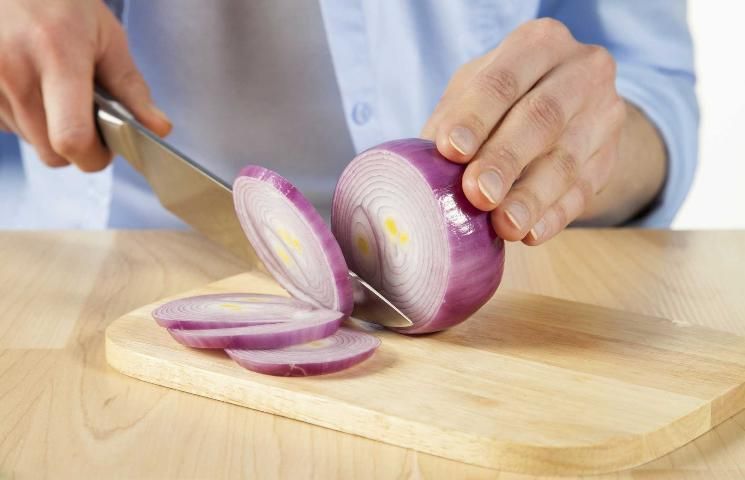What Are Flavonoids?
Flavonoids are organic compounds that occur naturally in plants. More than five thousand flavonoid compounds exist in nature, but those found in foods fall into six major categories: flavonols, anthocyanidins, isoflavones, flavan-3-ols, flavones, and flavonones (Erdman et al. 2007). Flavonoids are of interest because of their potential health benefits. Higher intakes of flavonoids are associated with a decreased risk of all-cause and cardiovascular mortality (Grosso et al. 2017).
Flavonols (FLAY-vo-nols)
Flavonols are the most commonly known and widespread flavonoids found in food (Erdman et al. 2007). Studies have shown that eating foods high in flavonols may reduce the risk for cardiovascular disease (Peterson et al. 2012; Grosso et al. 2017). Flavonols can be found in small amounts in a variety of fruits and vegetables, although some foods are better sources than others. Some of the best-known sources of flavonols are listed in Table 1 (Bhagwat, Haytowitz, and Holden 2013).

Credit: Maryna Pleshkun/iStock/Thinkstock.com
Anthocyanidins (AN-tho-sigh-an-ah-dins)
Anthocyanidins are the compounds that give many fruits and vegetables their red, blue, or purple color. These are antioxidants thought to protect the body from free radicals. Free radicals are unstable molecules that damage healthy cells. An imbalance between free radicals and the body's ability to protect itself against these damaging particles results in oxidative stress. Anthocyanidins act as strong antioxidants by neutralizing free radicals (Erdman et al. 2007). This reduces the oxidative stress on the body and cellular damage. For more information on antioxidants, see the EDIS publication Facts about Antioxidants (https://edis.ifas.ufl.edu/publication/fs242).
The anthocyanidin content of fruits and vegetables is highest in the fresh/raw form of these foods. For example, cranberries have a very high anthocyanidin content, but cranberry sauce and cranberry juice or cocktail contain very low amounts. This is mainly because the heat used in cooking and processing greatly reduces the flavonoid content of foods. Also, the production of fruit juice usually involves steps aimed at removing flavonoids in order to avoid discoloration (Manach et al. 2004). The best-known sources of anthocyanidins are listed in Table 2 (Bhagwat et al. 2013).

Credit: Carly Hennigan/iStock/Thinkstock
Isoflavones (I-so-FLAY-vones)
Isoflavones are found mostly in soybeans and soy products, such as soy milk and tofu (Bhagwat, Haytowitz, and Holden 2008). Isoflavones exhibit anti-inflammatory, antioxidant, anticancer, and antimicrobial effects. As inflammation is involved in many chronic diseases, such as heart disease, isoflavones may have a role in the prevention of some chronic disease (Yu et al. 2016). However, potential negative effects of high intake are also being studied (Yu et al. 2016); isoflavones are not associated with increased risk of breast cancer and instead, may decrease risk (Zhao et al. 2019) The isoflavone contents of some popular foods are listed in Table 3 (Bhagwat et al. 2008).
Flavan-3-ols (FLAY-vahn-three-ols)
Similar to other flavonoids, flavan-3-ols, from green tea and cocoa products are known for their anti-inflammatory effects (Mena et al. 2014). The common sources for flavan-3-ols are listed in Table 4 (Bhagwat et al. 2013).

Credit: wavebreakmedia/iStock/Thinkstock.com
While black tea, red wine, and dark chocolate contain flavan-3-ols, they should be consumed in moderation. For example, due to the caffeine content of tea, drinking more than five cups of black tea per day may cause unwanted side effects. These effects may include headaches, vomiting, and diarrhea (MedlinePlus 2012).
Consuming too much wine also can have negative effects, due to wine’s alcohol content. The Dietary Guidelines for Americans 2020-2025 recommend that if alcohol is consumed, it should be in moderation, which is defined as one glass per day for women and two glasses per day for men (USDHHS and USDA 2020). Women who are pregnant and people with certain chronic diseases, such as liver disease or pancreatitis, are advised to avoid alcohol.
Dark chocolate, while rich in flavan-3-ols such as catechins (Kerimi and Williamson 2015), is high in fat and calories. To get the most from chocolate while avoiding excess energy intake, limit yourself to small, bite-size pieces of chocolate, and choose dark chocolate as opposed to milk chocolate.
Flavones and Flavanones
Parsley contains high levels of flavones whereas flavanones are found primarily in citrus fruits (Bhagwat, Haytowitz, and Holden 2013). As with other flavonoids, flavones and flavanones are associated with protection against heart disease (Grosso et al. 2017)
Take-Home Message
A diet containing foods high in flavonoids may reduce the risk of cardiovascular disease. However, more research must be done before specific intake recommendations can be made. To reap the potential benefits of flavonoids, choose fruits and vegetables known to be good sources of flavonoids and follow the US Dietary Guidelines for Americans, which recommend eating fruits and vegetables every day (USDHHS and USDA 2020). An easy way to accomplish this is by aiming to make half of your plate fruits and vegetables (USDA and CNPP 2011).
References
Bhagwat, S., D.B. Haytowitz, and J.M. Holden. 2008. USDA Database for the isoflavone content of selected foods release 2.0. Beltsville, Maryland: U.S. Department of Agriculture.
Bhagwat, S., D.B. Haytowitz, and J.M. Holden. 2013. USDA Database for the flavonoid content of selected Foods Release 3.1. Beltsville, Maryland: U.S. Department of Agriculture.
Erdman, J. W., Jr., D. Balentine, L. Arab, G. Beecher, J. T. Dwyer, J. Folts, J. Harnly, et al. 2007. "Flavonoids and heart health: proceedings of the ILSI North America Flavonoids Workshop, May 31-June 1, 2005, Washington, DC." Journal of Nutrition 137 (3 Suppl 1):718s-737s. https://doi.org/10.1093/jn/137.3.718S.
Grosso, G., A. Micek, J. Godos, A. Pajak, S. Sciacca, F. Galvano, and E. L. Giovannucci. 2017. "Dietary flavonoid and lignan intake and mortality in prospective cohort studies: Systematic review and dose-response meta-analysis." American Journal of Epidemiology:1-13. https://doi.org/10.1093/aje/kww207.
Kerimi, A. and G. Williamson. 2015. "The cardiovascular benefits of dark chocolate." Vascular Pharmacology 71:11-5. https://doi.org/10.1016/j.vph.2015.05.011.
Manach, C., A. Scalbert, C. Morand, C. Remesy, and L. Jimenez. 2004. "Polyphenols: food sources and bioavailability." American Journal of Clinical Nutrition 79 (5):727-47. https://doi.org/10.1093/ajcn/79.5.727.
MedlinePlus 2012. Black Tea. https://medlineplus.gov/druginfo/natural/997.html. Accessed June 6, 2022.
Mena, P., R. Dominguez-Perles, A. Girones-Vilaplana, N. Baenas, C. Garcia-Viguera, and D. Villano. 2014. "Flavan-3-ols, anthocyanins, and inflammation." IUBMB Life 66 (11):745-58. https://doi.org/10.1002/iub.1332.
Peterson, J. J., Dwyer, J. T., Jacques, P. F., and McCullough, M. L. 2012. "Associations between flavonoids and cardiovascular disease incidence or mortality in European and US populations." Nutrition Reviews, 70, 491-508. https://doi.org/10.1111/j.1753-4887.2012.00508.x.
US Department of Agriculture. Center for Nutrition Policy and Promotion. 2012. "MyPlate Graphics." https://myplate-prod.azureedge.us/sites/default/files/2020-12/MyPlate_blue_0.jpg. Accessed June 6, 2022.
US Department of Health and Human Services and U.S. Department of Agriculture. (USDHHS and USDA). 2020. 2020–2025 Dietary Guidelines for Americans. 9th Edition. https://www.dietaryguidelines.gov/sites/default/files/2020-12/Dietary_Guidelines_for_Americans_2020-2025.pdf. Accessed March 16, 2021.
Yu, J., X. Bi, B. Yu, and D. Chen. 2016. "Isoflavones: Anti-inflammatory benefit and possible caveats." Nutrients 8 (6). https://doi.org/10.3390/nu8060361
Zhao, Ting-Ting, Feng Jin, Ji-Guang Li, Ying-Ying Xu, Hui-Ting Dong, Qun Liu, Peng Xing, Guo-Lian Zhu, Hao Xu, and Zhi-Feng Miao. 2019. Dietary isoflavones or isoflavone-rich food intake and breast cancer risk: a meta-analysis of prospective cohort studies. Clinical Nutrition 38 (1): 136-145. https://doi.org/10.1016/j.clnu.2017.12.006.